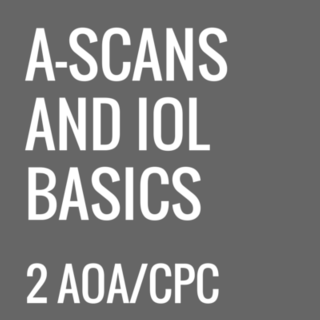
A Scans and IOL Basics
This course, for beginning, intermediate, and advanced levels, has been awarded 2 continuing education credits by the AOA/CPC. Covered topics: A-Scan measurements, IOL types, and IOL calculation formulas.
After completing this section the student should be able to do the following:
- Define what biometry testing of the eye is
- Define the following in terms of ultrasound: frequency, wavelength, velocity, amplitude
- Define Hertz in terms of frequency
- Describe reflectance
- Identify the frequency of oscillation of most A Scan machines in Hertz
- List the ocular structures that create peaks on an A Scan
- Describe the 2 methods of testing axial length
- Explain how corneal compression affects axial length
- State the rule for error induced with corneal compression of .1 mm
- Use the equation for finding axial length from velocity and time
- Identify the ocular structure responsible for the main spikes in an A Scan (cornea, anterior and posterior lens, retina, sclera, orbital fat)
- List 3 common mistakes that will result in lower spike levels
- State what the average length of the following structures are: eye, anterior chamber, lens
- Describe why longer than average eyes may need a lower power IOL
- Describe why shorter than average eyes may need a higher power IOL
- List the parts to the A Scan machine
- Describe the steps to use to take an A Scan measurement
- Describe how comparing anterior chamber depth can help with error tracking
- Describe how evaluating spike height can help with error tracking
- Describe the gain level and how it affects the A Scan graph
- List 2 methods of performing non contact axial length measurements
- Identify 2 types of scleral shells
- Describe the spike pattern on an immersion A Scan
- Explain how the double cornea spike is helpful in error tracking
- List the steps to follow to perform immersion A Scan biometry
- List 2 drawbacks to the IOL master
- List 3 drawbacks when using immersion A Scans
- Describe what the IOL Master does
- List 3 advantages to measuring axial length with the IOL Master or Lenstar versus A Scan
- Describe what optimization of the IOL Master and Lenstar does
- List the measurements that are taken with the IOL Master and Lenstar
- Describe what Keratometry, anterior chamber depth, and white to white are measurements of
- Describe what special considerations need to be taken when measuring axial length of a pseudophakic eye
- Describe what special considerations need to be taken when measuring axial length of a silicone oil eye
- Describe how a posterior staphyloma can affect axial length measurement
- List the 3 materials used to make IOLs
- Describe what theoretical and regression IOL calculation formulas are
- List 5 IOL calculation formula names
- Describe what the following IOL types do: monofocal, Multifocal, toric
- List 3 types of Multifocal IOLs
- Describe how the Crystalens works
- List 2 types of toric IOLs
- Describe the 2 basic IOL shape designs
This course should take approximately two hours to complete. Successful completion of the post test is necessary to earn AOA/CPC credit. The link for the post-test is included in the course material. This course is not sponsored by the AOA/CPC; only reviewed for compliance with AOA/CPC standards and criteria and awarded continuing education credit accordingly.
This course was developed by our partners at Eye-Courses.
